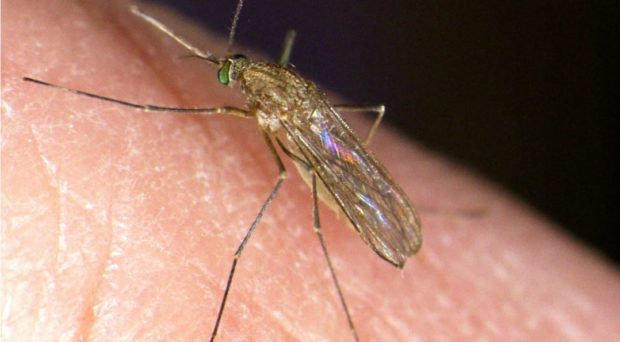
Culex pipiens pipiens feeding on a human host. (Courtesy of Fabrizio Montarsi, from Otranto, Dantas-Torres et al., 2013)
Cytoplasmic incompatibility in mosquitoes
Along with other insect populations of economic importance, the phenomenon of cytoplasmic incompatibility (CI) has been widely documented in natural mosquito populations of a given species, as well as in closely related species groups. CI restricts gene-flow and results in post-zygotic reproductive isolation and speciation events.
Origin of cytoplasmic incompatibility
The phenomenon of cytoplasmic incompatibility has been ascribed to the presence of intracellular, obligate, maternally inherited rickettsia-like symbiotic microorganisms of the genus Wolbachia. Rendering mosquito larvae free from this infection (aposymbiotic) by treatment with tetracycline restores bidirectional fertility in reciprocal crosses.
The underlying mechanism of CI, however, remains unsettled for a myriad of reasons: (i) conflicting results for not matching crossing relationships observed, (ii) discordant segregation of cytoplasmic properties and crossing-types with common maternal ancestor, (iii) mode of action of these causative agents rendering sperms incapacitated/arresting karyogamy .
Wolbachia strains are known to be highly diverse which in turn seemed to explain variation in levels of cytoplasmic incompatibility observed in natural mosquito populations.
In general, mosquito females harboring Wolbachia strains show compatibility with males infected with a similar type vis-à-vis, both sexes infected with different strains resulting in sterility. Interestingly, uninfected males are compatible with infected females irrespective of strain/mixed stains (superinfection). Conversely, uninfected females are incompatible with infected males.
Genetics of cytoplasmic incompatibility: empirical evidence
Based on crossing schemes, unidirectional fertility observed in intraspecific (between populations) and interspecific (between species) crosses was ascribed to the nucleus-independent maternal lineage so called ‘cytoplasmic incompatibility’.
For example, crosses involving Aedes malayensis females x Ae. alcasidi males was fertile whereas reciprocal cross involving Ae. alcasidi females x Ae. malayensis males (despite insemination) was sterile (all eggs laid were inviable).
The hybrid males derived from the cross (Ae. malayensis females x Ae. alcasidi males) also did not yield viable progeny when backcrossed to Ae. alcasidi females, thus incompatibility showed a strictly maternal mode of inheritance illustrated as below:
| Female | Male | ||
| Ae. malayensis (w+) | Ae. alcasidi (w-) | F1 (Ae. malayensis x Ae. alcasidi) | |
| Ae. malayensis (w+) | + | + | + |
| Ae. alcasidi (w-) | – | + | – |
| F1 (Ae. malayensis x Ae. alcasidi)* | + | + | + |
*In hybrid cross, the first named species in parenthesis was used as the female parent.
(+) = compatibility, (-) = incompatibility, (w+) = Wolbachia present, (w-) = Wolbachia absent. In this case, while Ae. malayensis is known to harbor Wolbachia (w+), Ae. alcasidi is free from this infection (w-).
Note that incompatibility results when Wolbachia infected males are crossed with uninfected females.
In this case, a sequential backcrossing scheme aiming at genomic replacement also did not alter the compatibility status of the first female parent used in the hybrid cross, proving the hypothesis that the phenomenon of CI is a nucleus independent, stable, and permanent trait.
Furthermore, in Culex pipiens mosquitoes, it has been demonstrated that CI persists throughout life span of mosquito irrespective of age of parents involved.
Similar phenomenon was recorded to be seen between many other closely related species of the Aedes (Stegomyia) scutellaris group, vectors of filariasis in the South Pacific Islands.
Cytoplasmic incompatibility: an efficient barrier to genetic flow/introgression
This naturally occurring phenomenon of CI has played a pivotal role in evolution and speciation by restricting gene-flow and introgression between inbreeding populations of a given species, as well as between species and hybrids. Furthermore, it could function in a gene-drive system for mosquito genome replacement, as well as for the reduction of population size or for modulating population age structure to reduce disease transmission.
Accordingly, it has been postulated that Wolbachia might be used (i) as a tool to drive desirable genotypes into arthropod populations, and (ii) to directly suppress or modify natural insect vector populations.
Implications in population control
The success story of eradication of Culex pipiens fatigans (a vector of bancroftian filariasis) through CI in a defined geographical area has been documented. The scheme encompassed a mass-release of bidirectionally incompatible males of the target species which, as such, are innocuous as they do not require bloodmeal.

Insect vector population control by CI has obvious advantages for being cost savvy, obviating the need for the application of insecticides, and consequently averting emerging insecticide resistance. In addition, the existing ethical guidelines and practices for a mass-release program will suffice without exercising a plethora of rules and regulations for achieving permission expeditiously.
If cytoplasmic incompatible males were used for control of Aedes albopictus (the Asian tiger mosquito) there is an added advantage as, relative to uninfected females, infected females have a reproductive advantage due to both CI and a fitness increase associated with Wolbachia infection in terms of host longevity, egg hatch rates, and fecundity.
One-size-does-not-fit-all: a favorable time for renewed attack
If, in a given region, there is a diversity in the Wolbachia strains co-circulating and exhibiting CI, the situation offers an opportunity to exploit it for control of indigenous vector populations. Thus, there exists the possibility of the integration of this Incompatible Insect Technique (IIT) with other control methods such as Sterile Insect Technique (SIT) and the use of larvicides for effective management of insect vector populations.
Population-cage experiments utilizing CI strains have proven to be a gala success. This technology does hold promise for large scale releases for the control of insect vectors of economic importance that could prove to be a novel environmentally friendly tool.

Comments